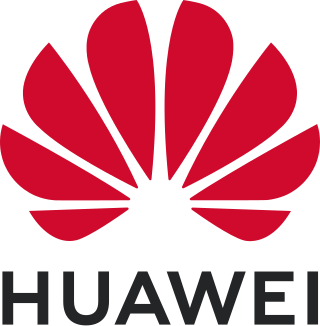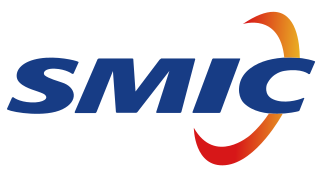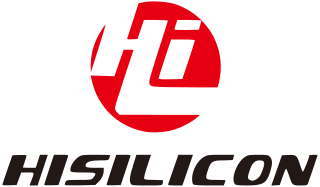
Huawei Technologies Co., Ltd. is a Chinese multinational conglomerate technology corporation headquartered in Longgang District, Shenzhen, Guangdong province. It designs, develops, manufactures and sells digital telecommunications equipment, consumer electronics, smart devices, distributed operating systems, electric vehicle autonomous driving systems, and various rooftop solar products. The corporation was founded in 1987 by Ren Zhengfei, a former officer in the People's Liberation Army (PLA).

Semiconductor Manufacturing International Corporation (SMIC) is a partially state-owned publicly listed Chinese pure-play semiconductor foundry company. It is the largest contract chip maker in mainland China.

HiSilicon is a Chinese fabless semiconductor company based in Shenzhen, Guangdong province and wholly owned by Huawei. HiSilicon purchases licenses for CPU designs from ARM Holdings, including the ARM Cortex-A9 MPCore, ARM Cortex-M3, ARM Cortex-A7 MPCore, ARM Cortex-A15 MPCore, ARM Cortex-A53, ARM Cortex-A57 and also for their Mali graphics cores. HiSilicon has also purchased licenses from Vivante Corporation for their GC4000 graphics core.

The Huawei P8 is a Huawei P Series high-end Android smartphone produced by Huawei. It was originally released in April 2015, alongside two different versions:
The Huawei Nova and Huawei Nova Plus are mid-range smartphones manufactured by Huawei. They were announced and released at the Internationale Funkausstellung Berlin (IFA) on Sept. 1, 2016.

Huawei Mate, formally Huawei Ascend Mate, is a series of high-end HarmonyOS-powered phablet smartphones produced by Huawei, and is one of their flagship products along with the Pura series.

The Huawei Pura series is a line of high-end and medium-range smartphones produced by Huawei, based on its proprietary HarmonyOS mobile operating system. The P series was formerly marketed as part of Huawei's larger Ascend brand, and some models were called P smart.
The Chinese multinational information technology and consumer electronics company Huawei has faced numerous criticisms for various aspects of its operations, particularly in regards to cybersecurity, intellectual property, and human rights violations.
HarmonyOS (HMOS) is a distributed operating system developed by Huawei for smartphones, tablets, smart TVs, smart watches, personal computers and other smart devices. It has a microkernel design with single framework: the operating system selects suitable kernels from the abstraction layer in the case of devices that use diverse resources.

Huawei Mate 30 is a line of Android-based phablets manufactured by Huawei as part of its Huawei Mate series, and the successor to the Mate 20. The Mate 30 comprises the Mate 30/5G, Mate 30 Pro/5G, and Mate 30 RS Porsche Design, which were unveiled on 19 September 2019 in Munich, Germany.

Huawei Mate 40, Huawei Mate 40 Pro, Huawei Mate 40 Pro Plus and Huawei Mate 40 RS Porsche Design is a high-end Android and HarmonyOS based phablets developed by Huawei for its Mate series, succeeding the Huawei Mate 30 range. They were released on October 22, 2020 at Huawei's Online Global Launch Event.
Tiantong is China's first mobile communications satellite system. The first satellite Tiantong-1-01 was launched on August 6, 2016 (UTC+8).
The version history of the HarmonyOS distributed operating system began with the public release of the HarmonyOS 1.0 for Honor Vision smart TVs on August 9, 2019. The first expanded commercial version of the Embedded, IoT AI, Edge computing based operating system, HarmonyOS 2.0, was released on June 2, 2021, for phones, tablets, smartwatches, smart speakers, routers, and internet of things. Beforehand, DevEco Studio, the HarmonyOS app development IDE, was released in September 2020 together with the HarmonyOS 2.0 Beta. HarmonyOS is developed by Huawei. New major releases are announced at the Huawei Developers Conference (HDC) in the fourth quarter of each year together with the first public beta version of the operating system's next major version. The next major stable version is then released in the third to fourth quarter of the following year.

AITO is a Chinese electric vehicle marque of Chinese vehicle manufacturer Seres Group and multinational technology corporation Huawei in 2021. The marque offers electric cars with autonomous driving systems and the HarmonyOS operating system.
NearLink, also known as SparkLink and formerly Greentooth is a short-range wireless technology standard, which was developed by the NearLink Alliance, led by Huawei to set up on September 22, 2020. As of September 2023, the Alliance has more than 300 enterprises and institutions on board, which include automotive manufacturers, chip and module manufacturers, application developers, ICT companies, and research institutions.
Harmony Intelligent Mobility Alliance, trading as HIMA is an automotive alliance initiated and led by Chinese multinational technology company Huawei. Established in 2023, the members of the alliance include AITO, Luxeed (Chery), Stelato, and Maextro.
Qingyun L540 is a Chinese laptop computer product of Huawei released in 2023 with market target to Enterprise and China's public sector. It uses ARM technology Kirin 9006c SoC microprocessor 5 nm architecture, supports 16 GB RAM, 512 GB UFS. It has a 14-inch 4k display. It's predecessor Huawei Qingyun L420 with English name called, 'Dyna Cloud L420' model released in 2021 from TSMC 2020 production of the same stockpiled chips. The first model, Huawei Qingyun L410 featured, Kirin 990 released in May 2021, earlier in the year, that runs Unity Operating System like all successor models.
Shenzhen Yinwang Intelligent Technology Co., Ltd, or trade as "Yinwang" is a company of Huawei which specialized in providing parts and hardware and software solutions for automotive manufacturers. The company was formerly known as Huawei Intelligent Automotive Solution, the automobile business unit of Huawei.









